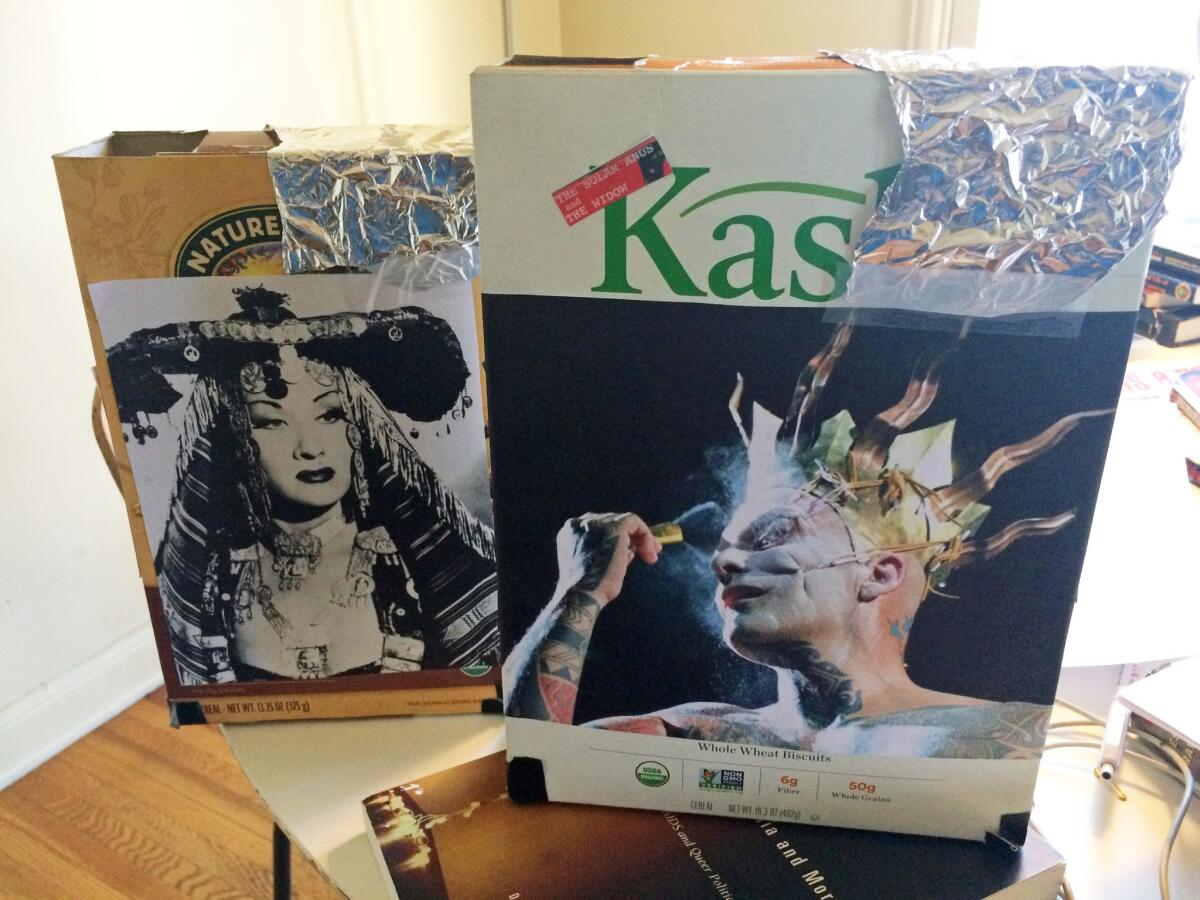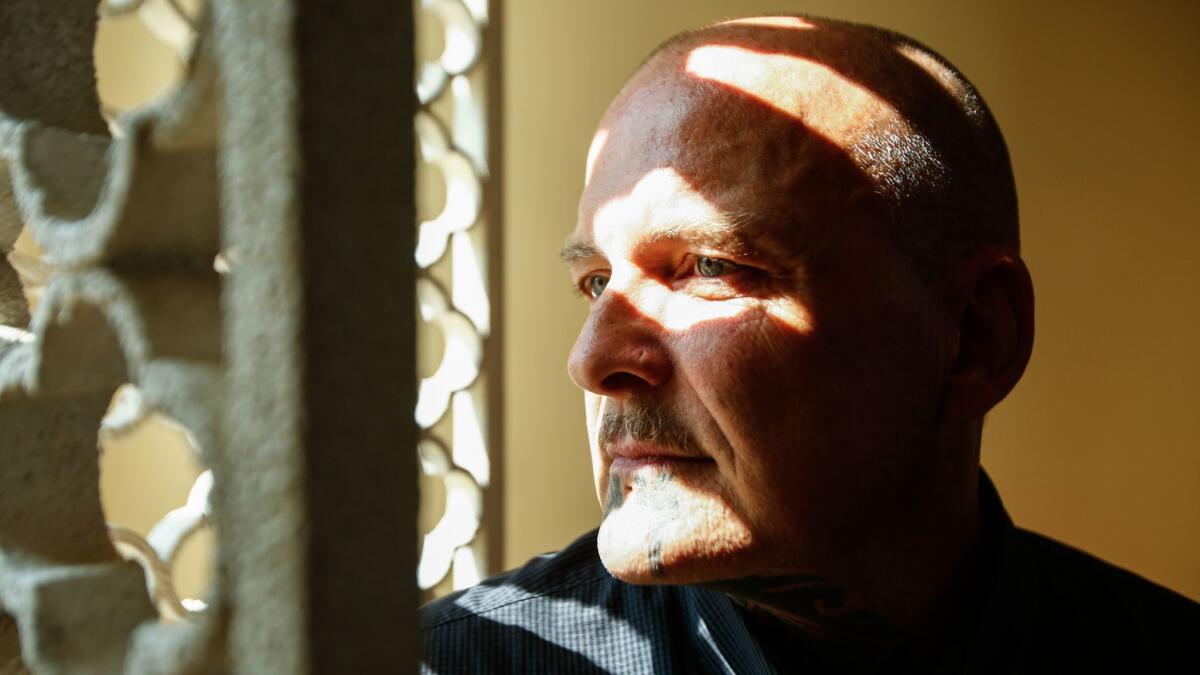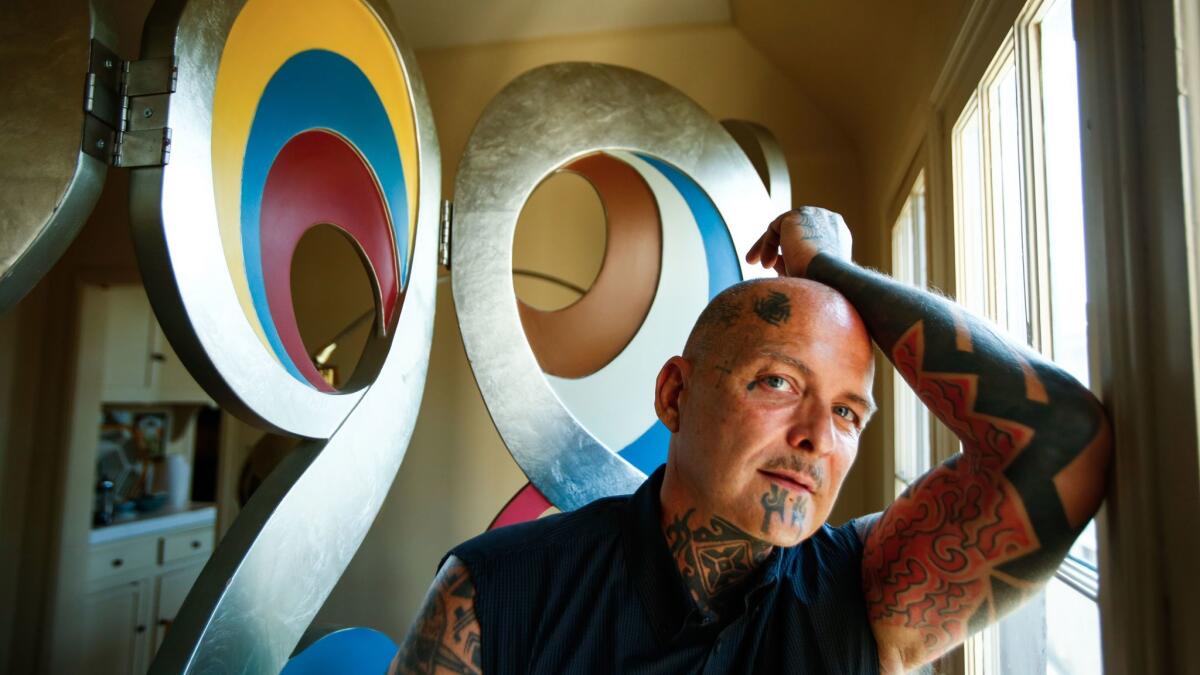Q&A: Has former NEA target Ron Athey bled enough for his art? He’s back with a new happening at the Broad

Ron Athey and L.A. Times reporter Carolina Miranda watch the solar eclipse with homemade devices, then talk about natural phenomena and systems of logic.
I arrive at Ron Athey’s Silver Lake apartment on Monday morning bearing two cereal boxes craftily transformed into eclipse viewing devices. The artist, after all, is known to have an interest in the sun. He is the creator of numerous gritty works of performance, including “Solar Anus,” which incorporates an elaborate sun pattern tattooed on his rear.
If you’re going to do an interview with Athey in the middle of a solar eclipse, it’s good to show up prepared to watch the sun.
“I’m definitely seeing flashes,” Athey says as we peer into our boxes — the projected light revealing a sun partly obscured by the moon. “Or flashbacks!”
It would be easy to reduce Athey and his work to a punchy tabloid headline — and, in fact, that has happened before.
The artist made a name for himself in the 1990s with a series of deeply layered performances called the “Torture Trilogy” that explored fetish, pain, Christian myth, sexuality and the politics of queerness during some of the worst years of the
Athey’s performances are not for the squeamish, involving piercing, bloodletting and the sorts of torture implements that might have been employed during the Inquisition. In the pain, he has said, he finds moments of the “sublime.”
In 1994, his work drew the ire of conservative politicians after it was discovered that a performance he staged at the Walker Art Center in Minneapolis was partly funded — to the tune of $150 — by the National Endowment for the Arts. Cue hellfire and brimstone on the cable news networks courtesy of the now-deceased Sen.
But the Los Angeles artist — the Pomona-raised son of highly devout Pentecostals — is back. Last year, Catherine Opie featured a portrait of Athey in her recent photo exhibition at the Hammer. This semester, Athey is teaching a class on subcultures and undergrounds at USC’s Roski School of Art and Design. On Saturday, he’s hosting a night of performance at the Broad museum in downtown Los Angeles, tied to the exhibition “Oracle,” which is inspired by globalization and surveillance themes. He’s also at work on a major new performance piece that recently garnered support from the Mike Kelley Foundation.
Athey greets me warmly when I land at his place, offering coffee, jokes and scatological references to French philosophy. Now 55, the artist sports a dapper mustache and an elaborate web of tattoos. In this lightly edited conversation, he talks about his new L.A. project, why “Solar Anus” was so important and why he thinks after 30 years he’s bled enough for his art.
Tell me what the eclipse means to you.
I think of the queeniest reference — of Farinelli screaming at the king of Spain, from that movie [Gérard Corbiau’s 1994 film “Farinelli”] about the castrato singer. It was that period when art movies started being mainstream movies. If we had a castrato in a gown singing, we’d be gushing harder at this eclipse. You have to invest in drama.

For the happening at the Broad, which you organized with filmmaker James Spooner, musicians will perform “a soundtrack for the apocalypse,” and artist Linda Mary Montano, channeling Mother Teresa, will offer healings and blessings. This sounds like a reaction to recent news events.
It’s the news of the moment, the news we’ve been leading up to for a while! I’ve always seen things in terms of vision and prophecy unfolding. I was made for apocalypse. I’m ready to roll. I just didn’t expect all of the tedium to go with it.
[For the Broad happening,] Linda will do blessings as Mother Teresa in what the museum calls the lobby, but what I call “the man cave.” She is the oracle. The first time I saw Linda perform, she had been massaged for seven hours before the performance. And so it fascinated me, to see someone in this Jell-O state come out in this Stevie Nicks wig and play the keyboards. I’m a big fan. And I’ve never known her to do anything in L.A.
There will also be a Xenolalia Room. Xenolalia is babble. It’s this Christian missionary myth of landing on the shores of China or South America and just speaking that language fluently as given to you by God. So there will be poets there — Raquel Gutiérrez, Elliot Reed, Lisa Teasley — and music. Sound communicates one way and words communicate another. So it’s this mixing in a non-lyrical, musical way, an incantation.
I was made for apocalypse. I’m ready to roll. I just didn’t expect all of the tedium to go with it.
— Ron Athey, artist

We are in a cultural moment in which there is a lot of discussion about the body: the black body, the queer body, the trans body, women’s bodies — and the politics of those bodies. In some way, ideas that connect quite intimately with your work.
In the era of extreme normal, I guess I’m normal.
It was my passion for 30 years. I think a lot of things I was trying to do with the body had to do with ecstatic states. I think that’s why I did bleeding performances for so long. It was the only thing that brought me to that space. There is no stage fright or worry when you are having this experience.
But in the last performances, I didn’t feel as in it. I was a bit outside myself. I thought, “Maybe I’ve bled enough.” Being in my mid-50s doing the “Self Obliteration” series, it was almost a defiance, that age doesn’t matter, that the post-AIDS body (if we’re dragged into that label) doesn’t matter. That this body that has been through all of these things is here.
I’ve been so inside the body, but I had to step back. The performance I’m working on now isn’t about the body at all. It’s about formation. It’s about connectivity. But I’m still not a minimalist. I always want the next level, the next phase. I want to be turned out!
What can you tell us about the new performance?
It’s “Gifts of the Spirit” — it’s what the Mike Kelley grant is for. It was something I started writing when I was a teenager and I left home and I didn’t know who I was. When I got excited, I still spoke in tongues. I couldn’t change my lens, so I started writing my understanding of these gifts, which included automatic writing.
So I’ve taken these stories that I’ve never been able to finish and I used key points in each story as a hypnotic suggestion so that we can, in real time, make a collectively authored text with 16 writers, two editors and six typists using manual typewriters. So I read a one- or two-minute prompt, the writers then have five to six minutes to write while under a level of hypnotic induction. Then the story is brought to the typist and you have this reading and writing and this clackety. There’s this buildup, and that text is cut up and put together and the new text is delivered with music and that new text is an opera libretto.
It’s written as a sound score. I wanted to work with a composer and an opera director. But we haven’t found the right word for it. Is it an opera? Is it a sound installation? Or writing? I love opera because you blow up real issues — you stylize them and bloat them. I love the bloat of opera.
I’ll be doing it for 2018 — in January, with the Broad.
You lived in London for half a dozen years. How does it feel to be back in L.A.?
Six years was just long enough for this to be a different Los Angeles on some levels. It feels like a much younger L.A. It’s like all of a sudden you go to Mustache Mondays [at La Cita bar in downtown] and everyone is 22!
London was great, but it was hard. It’s too expensive. I’d do a U.S. tour or a French tour and I’d change the money into pounds and I’d pay my rent and have nothing left. And the school system doesn’t pick up the slack for artists there. You get paid very little for talks.
I run on a sun cycle. I grew up in Southern California. I like the roughness, the happy stupidity. I even get a kick out of the anti-New Yorker things — now that we have a million New Yorkers here with their civic pride and their whole “I Love L.A.” thing.
I’ve been so inside the body, but I had to step back. The performance I’m working on now isn’t about the body at all.
— Ron Athey, artist

Looking back at all of the work you’ve made, which is the piece you feel closest to?
I feel like through the AIDS era I was working through a lot of things. “Solar Anus” came in this moment of real freedom in my head. I was like, “I’m going to make this piece and have it done in two weeks.” It was inspired by the Georges Bataille essay I’d had brewing in my head. He wrote this essay called “The Solar Anus” in 1927. It’s anal-centric — about the night and dayness of the asshole, the yin-yangness of it. And then I discovered [the French philosopher] Pierre Molinier, and he had this years-long fetish of stockings, high heels and penetration. And I began to have this obsession of having this solar anus tattoo. So it was this challenge — the challenge of doing a solo piece. And no matter how many times I did it, I was in it.
I had playful things, too...
In the absence of god — or having a god hole — as a former fundamentalist Christian, I have to fill it in with something. So I’m not into everything being apocalyptic, sort of a prophecy. I need some of it be healing and logical. I think systems of logic and the cosmos is something that comforts me. Finding logic is something I demand.
In a 2007 story in The Times, the critic Amelia Jones is quoted as saying that “Ron Athey’s asshole has its own place in the history of contemporary art.” Where in the art universe do you think that part of your anatomy currently resides?
Being contextualized in art history for your asshole alone is a feat. It’s under wraps this week. It’s not coming out for “Gifts of the Spirit” or the “Oracle” happening. Though it might be in my artist lecture introduction at the Roski School!
What would you be doing if you weren’t a performance artist?
I started out with a real love for science. When I was 16, I was an intern at the Jonas Salk Institute. I thought I’d be a biochemist. At the Living Desert [botanical garden] in Palm Desert, I once took a summer course on desert botany. Desert plants are a big love of mine. I could do a xeriscaping business in L.A. There are a lot of raggedy traditions here: the lawns, the bushes shaped like poodles. I’d rather see a nice xeriscaped garden than some poor lawn. I love the garden. I would have a botanical garden — the botanical garden with all the special poison and psychedelic plants.
“Summer Happenings at the Broad: Oracle” — guest curated by Ron Athey and James Spooner
When: Aug. 26 at 8 p.m.
Where: The Broad, 221 S. Grand Ave., downtown Los Angeles
Tickets: $25 in advance, $30 at the door. Ages 21 and over only.
Info: thebroad.org
Sign up for weekly Essential Arts & Culture Newsletter »
ALSO
The biggest entertainment stories
Get our big stories about Hollywood, film, television, music, arts, culture and more right in your inbox as soon as they publish.
You may occasionally receive promotional content from the Los Angeles Times.








